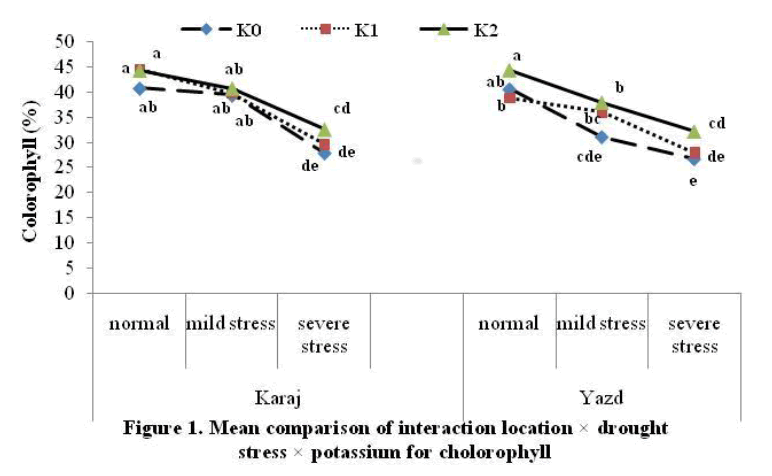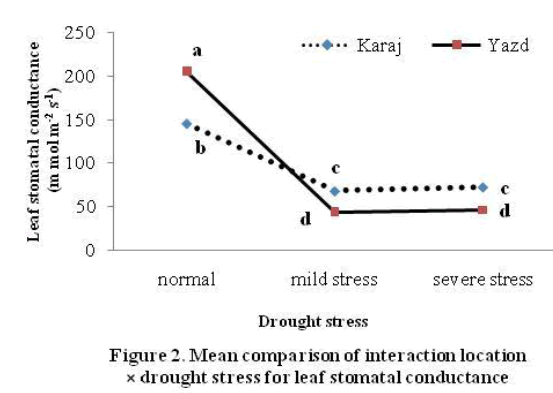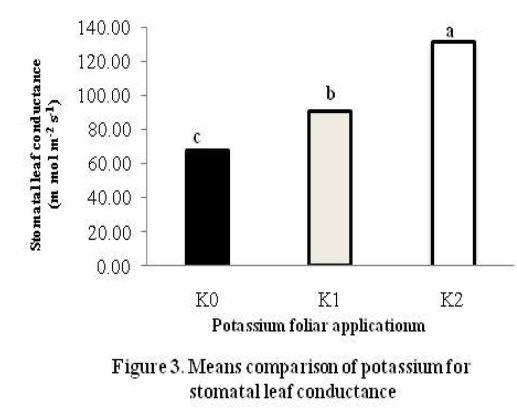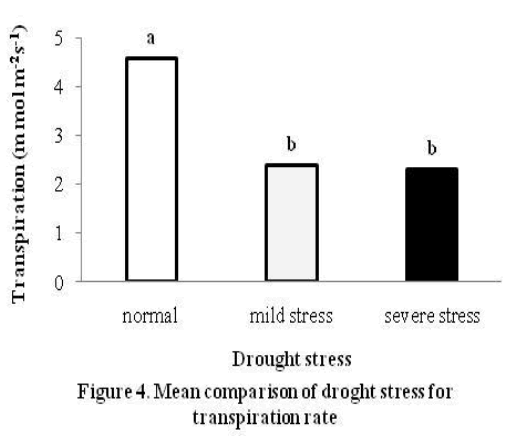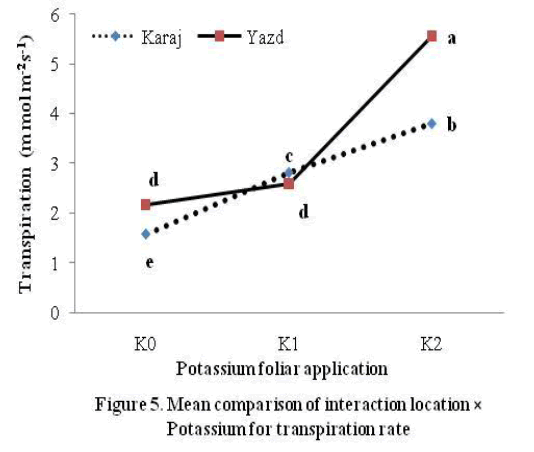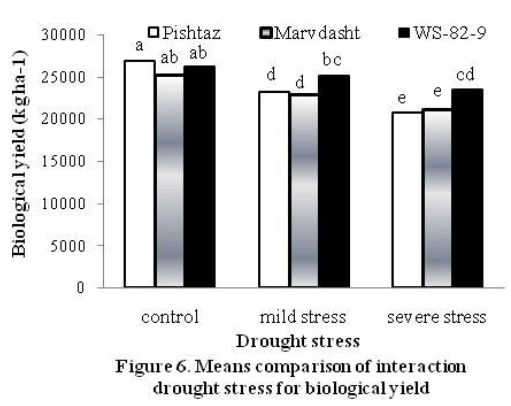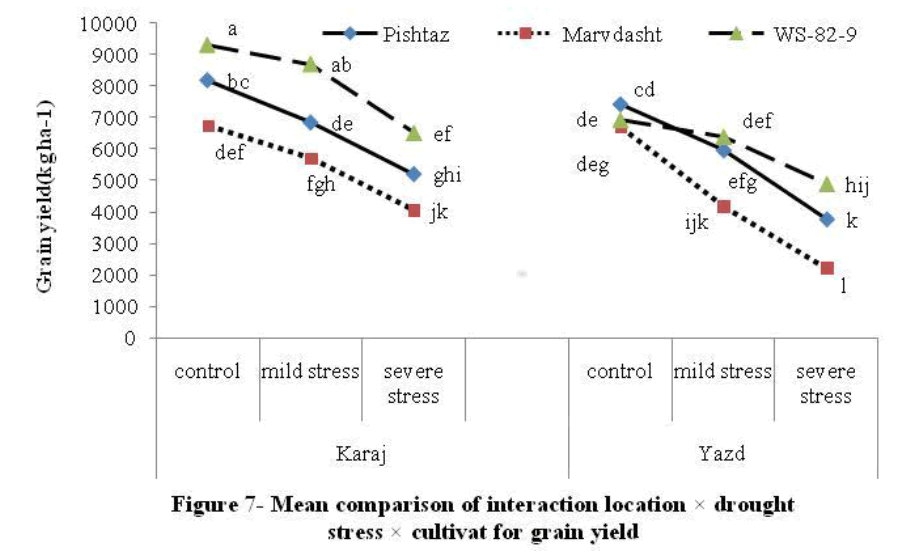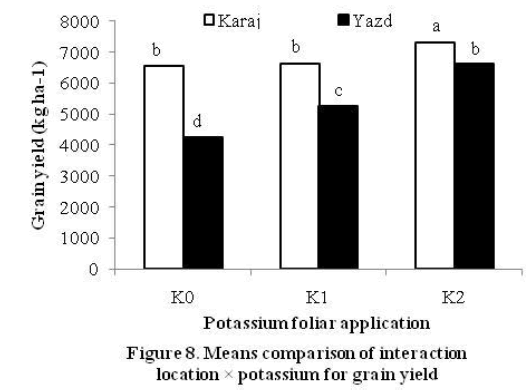Field Performance of Three Wheat Cultivars under Drought Stress and Potassium Foliar Application Treatments
Abbas Zareian, Seid Ali Tabatabaei
Abbas Zareian1,*, Seid Ali Tabatabaei2
1Department of Agronomy, Science and Research branch, Islamic Azad University, Tehran, Iran
2Agricultural and Natural Resources Research Center of Yazd, Iran
- Corresponding Author:
- Tel: +98(0)2632754071
Fax: +98(0)2632740333
E-mail: a_zareyan52@yahoo.com
Abstract
The effects of drought stress and potassium foliar application on grain yield and some physiological traits of three wheat (Triticum aestivum L.) cultivars, was studied through field experiments conducted during growing season of 2011-2012 at two locations, 1. Seed and Plant Certification and Registration Research Institute (SPCRI), Karaj- Iran 2. Agricultural and Natural Resources Research Center Yazd- Iran. The experiments were carried out using a split plot factorial based on a randomized complete blocks design with three replications. The experimental treatments included three irrigation regimes; normal, mild stress (water withheld at the grain filling phase) and severe stress (water withheld at the ear emergence phase); potassium foliar treatments included, 0, 1.5% and 3.0% K2O applications and three wheat cultivars (Marvdasht, Pishtaz and WS-82-9). Leaf stomatal conductance, transpiration rate, chlorophyll, biological yield and grain yield were measured. The results indicated that water stress through withholding at the ear emergence and grain filling phases reduced the above mentioned traits at the both locations. Also these traits showed significant increase by increasing potassium foliar application.
Keywords
Wheat, Grain yield, Stomatal conductance, Transpiration, Drought stress, Potassium foliar application.
1. Introduction
The relative decreases in maximum crop potential yield (i.e., yields under ideal conditions) associated with abiotic stress vary between 54-82% [4]. The greatest fear of global climatic change is drought and among the environmental stresses, drought is one of the most severe stresses for plant growth and productivity [7]. During grain filling in wheat, plants are subjected to some unfavorable conditions such as low winter rainfall, shortage of irrigation water and the need to withholding irrigation for saving water and early land evacuation for cultivating the following crop [10]. Although, drought can affect all growth stages of wheat plant, grain filling is considered to be one of the most sensitive growth stages to water deficit stress [6]. With increased drought stress lower growth and yield were determined in barely and corn [16,8]. Understanding of physiological mechanisms that enable plants to adapt to water deficit and maintain growth and productivity during stress period could help in screening and selection of tolerant genotypes and using these traits in breeding programs [25].
The response of a plant to environmental stress is determined by its nutritional status. One of the mechanisms for improving plant tolerance to drought is to apply K which seems to have a beneficial effect in overcoming soil moisture stress [20]. Available moisture and nutrition during grain development are the two main factors influencing grain development. Application of NPK to the plant influence grain composition which can also affect embryo development [21]. Increased application of K has been shown to enhance photosynthetic rate, plant growth and yield in different crops under water stress conditions [9,24].
The objective of this study was to find out the effects of drought stress and potassium foliar application on grain yield and some physiological traits of three wheat cultivars in Iran.
2. Materials and Methods
Two field experiments were conducted during 2011-2012 at two locations: 1- Seed and Plant Certification and Registration Research Institute (SPCRI), Karaj- Iran, 2- Natural Resources Research Center, Yazd- Iran. Chemical and physical traits of experimental soil are represented in Table 1. The experiments were carried out using a split plot factorial based on a randomized complete blocks design with three replications. Three irrigation regimes, control (normal irrigation), mild stress (water withhold at the grain filling phase) and severe stress (water withhold at the ear emergence phase), potassium foliar application, without foliar application (K0), 1.5% K2O (K1) and 3.0% K2O (K2) and three wheat cultivars (Marvdasht, Pishtaz and WS-82-9) comprised the experimental factors. Leaf stomatal conductance, transpiration rate, chlorophyll (after grain filling stage), biological yield and grain yield were measured. Seeds were sown on 15 and 19 November at Yazd and Karaj, respectively. Sowing density was 400 seeds m-2 by planting 500 seeds on each row. Plots were 5 m long and 2 m wide, with eight rows 0.25 m apart. All plants received irrigation until the imposition of treatments. Drought treatments imposed by withholding irrigation after ear emergence and grain filling phases. Plastic cover was used to protect from effective rainfall on plots under drought water stress. Urea, potassium sulphate and super phosphate were applied according to results of soil analysis. All plots received one-third of urea and all super-phosphate at sowing. Other two-third of urea was applied at the start of stem elongation, and before flowering, respectively. Plots for potassium foliar application treatments were assigned to three levels of treatments i.e. control treatment (without spraying), 1.5% and 3.0% K2O in the form of potassium sulphate (48 % K2O). The foliar solution was prepared at both rates and applied using hand sprayer at steam elongation stage. The youngest fully-expanded leaf (third from the apex), intact and full sunlit leaves per plot was used for measurements. Leaf stomatal conductance and transpiration rate were measured by the CI-340 Ultra-Light Portable Photosynthesis System. Measurements obtained by using Leaf Chamber attachments in conjunction with the CI-340. It contains a pump along with a mass airflow sensor. A built-in microprocessor regulates the airflow rate, which is set by the user. SPAD value or leaf chlorophyll content was measured by (SPAD-502, Minolta Co Ltd, Osaka, Japan). At harvest, a 3 m2 area was harvested from the center of each plot for grain yield.

Analysis of variance was carried out using SAS software. Treatment means were compared using Duncan's test at the 5% and 1% levels of significance and graph drawing was performed by means of Excel 2003 software. Bartlett test was used to test homogeneity of variances. Data expressed as percentages were transformed prior to analysis of variance by using arc sin transformation.
3. Results and Discussion
The results obtained from combined analysis of variance across two locations revealed significant difference (P<0.01) among different levels of drought stress, potassium foliar application, cultivars and their interactions (Table 2).
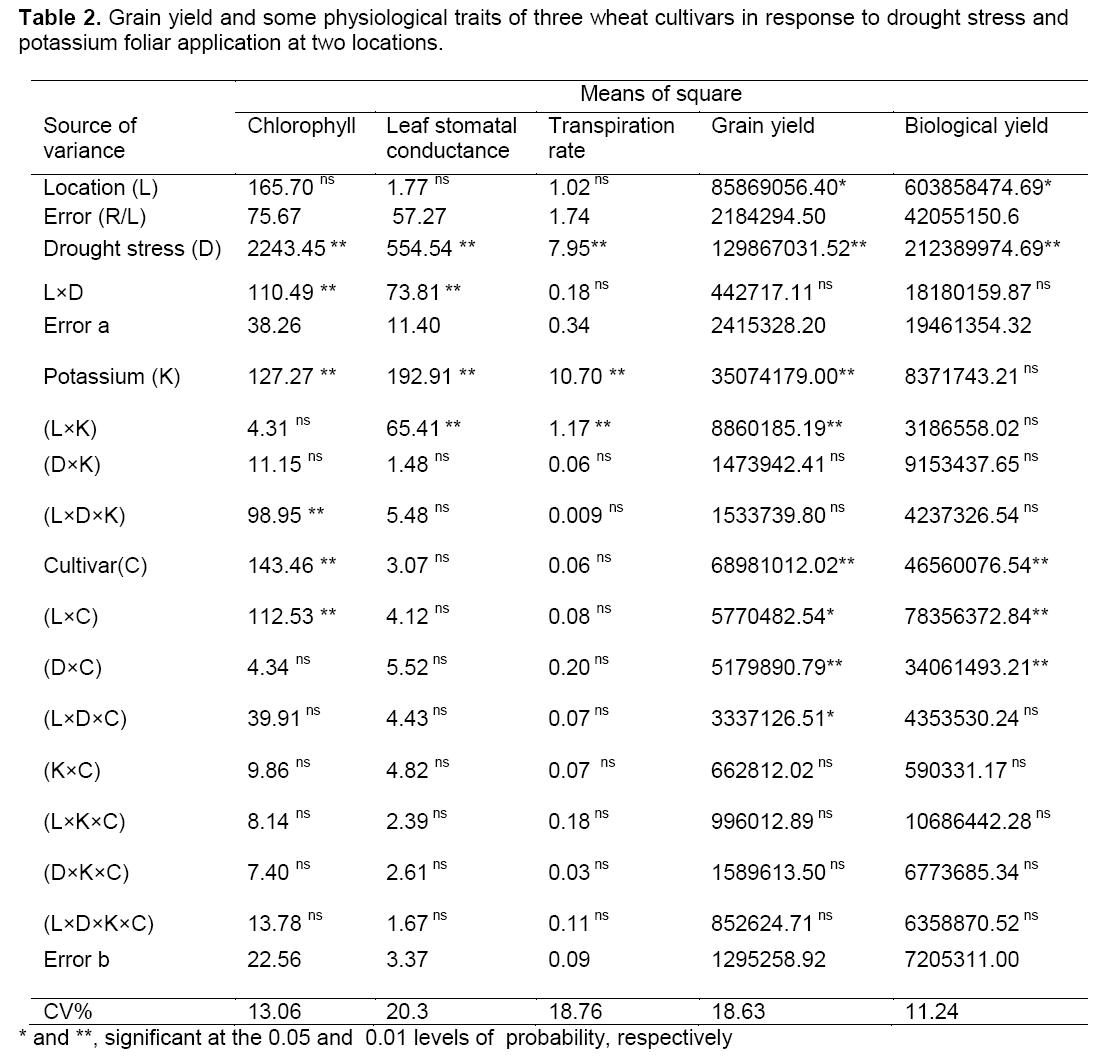
Chlorophyll
Interaction effects of location and drought stress and potassium foliar application was significant on chlorophyll (Table 2). Results showed that the efficiency of potassium fertilizer was different at both locations. For example, differences between chlorophyll in highest level and no potassium application at Yazd was 2.4% more than Karaj. Maximum chlorophyll content was attained under normal water use and spraying with 3.0% K2O at the both locations (44.3%) and minimum chlorophyll content was observed under severe stress and no potassium application treatments at Yazd (27.9%) (Figure 1). Improvement in chlorophyll due to potassium foliar application may be ascribed to the role of potassium in improving many physiological growth processes and delay plant leaves senescence as well as increasing photosynthetic activity. Numerous studies have shown that the application of potassium fertilizer mitigates the adverse effects of drought on plant growth in barley, sunflower and rice that confirmed result of this study [3,17,20]
Leaf stomatal conductance
Interaction effects of location and drought stress was significant on leaf stomatal conductance (Table 2). Results showed that drought stress had more negative effect on leaf stomatal conductance at Yazd area so that, this decrease was 53.36% and 78.6 mmol m-2s-1 at Karaj and Yazd area, respectively (Figure 2).
In a study on wheat, results showed that water deficit significantly decreased Stomatal conductance both at the vegetative and anthesis stages. Stress induced reductions in stomatal conductance were 60% and 50% for vegetative and anthesis drought, respectively as compared with the control treatment [22]. In other experiment on oil seed species (Brassica napus), leaf stomatal conductance consistently decreased under water stress in both species and sampling stages [13].
Spraying wheat plants with 3.0% K2O caused the highest value of leaf stomatal conductance followed by spraying plants with 1.5% K2O; while control treatment (without potassium foliar application) gave the lowest values of this character (Figure 3). It was reported that potassium control water loss from the plant through osmotic adjustment and positive role in closing of stomata [15]. When K+ is deficient, the stomata can not function properly and water losses from plant may reach damaging levels [14].
Transpiration rate
Results indicated that drought stress significantly affected on transpiration rate (Table 2). Transpiration rate was 4.57 and 2.28 mmol m-2s-1 in normal and severe water stress treatments, respectively (Figure 4). Similar results on mungbean (Vigna radiant L.) revealed that water deficit significantly decreased transpiration rate both at the vegetative and anthesis stages. Stress induced reductions in transpiration rate were 43% and 62% for mild and severe drought stress, respectively as compared with the control treatment [18].
Interaction effects of location and potassium foliar application was significant on transpiration rate (Table 2). Results showed that the efficiency of potassium fertilizer was different at both locations so that, differences between transpiration rate in highest level and no potassium application at Yazd was 80.2% more than Karaj (Figure 5). The function of stomata is to control water loss from the plant via transpiration. Improvement in transpiration rate due to potassium foliar application may be ascribed to the role of potassium in improving many physiological growth processes and delay plant leaves senescence. These results are in line with those stated by other researchers [1,11].
Biological yield
Significant interaction effects of drought stress and cultivar on biological yield showed that reaction of cultivars under drought stress conditions was different. Results showed under drought water stress, biological yield reduction in WS-82-9 was less than other cultivars (Figure 6).
In similar study was reported that biological yield of drought stress treatment was 21.5% lower than control [12]. Also they concluded that under drought stress, maximum and minimum values of biological yield were found with Kohdasht (13610 kg ha-1) and Cham-4 cultivars (10070 kg ha-1), respectively.
Grain yield
Interaction effects of location and drought stress and cultivar was significant on grain yield and harvest index (Table 2). Results showed that reaction of cultivars under drought stress conditions at both locations was different. By increasing drought stress the reduction of grain yield was approximately similar in three wheat cultivars at Karaj, but under severe stress at Yazd, yield decrease in WS-82-9 than Marvdasht was least that can be associated to its physiological characteristics. The highest value of grain yield was produced in WS-82-9 under normal water use at Karaj (9310 kg ha-1), while the lowest value of grain yield was observed in Marvdasht cultivar under severe drought stress at Yazd (2220 kg ha-1) (Figure 7). The results of a study on sorghum reported that grain yield of drought stress treatment were 36.6% lower than control. Also, they resulted that under drought stress, maximum and minimum values of grain yield were attained with M5 (3680 kg ha-1) and M3 lines (2830 kg ha-1), respectively [5]. This effect of water stress during grain filling on grain yield may be due to the reduction in rate and duration of filling processes and causing small grain size consequently reducing yield components (number of spikes per m2, number of grains per spike and 1000-grain weight) [19].
Potassium foliar application significantly increased grain yield at both locations. Results showed that the efficiency of potassium fertilizer at Yazd was much more than Karaj. For example, differences between grain yield in highest level and no potassium application at Yazd was 1616 kg ha-1 more than Karaj (Figure 8). Results of a study showed that under drought stress, high and low values of grain yield were produced with spraying 2.0 %K2O and 2.0% urea (781.2 g/m2) and no application potassium and urea (636.7 g/m2), respectively [2]. These increases may be ascribed to the role of foliar spray with potassium on increasing photosynthetic activity which accounts much for high translocation of photoassimilates from leaves to the grains. The other studies have shown that the application of potassium fertilizer mitigates the adverse effects of drought on plant growth in faba beans and sugar cane that confirmed result of this study [23].
Conclusion
Results showed that drought stress significantly affected on leaf stomatal conductance, transpiration rate, chlorophyll, biological yield and grain yield. Potassium foliar application mitigates the adverse effects of drought on plant growth and improved grain yield and physiological traits. The highest decrease in these traits was observed at Yazd area, because of unfavorable conditions. It is concluded that maximum values of grain yield could be achieved from wheat cultivar WS-82-9 giving normal irrigation and sprayed with 3.0% K2O.
References
- Abou El-Defan T. A., El-Kholi M. A., Rifaat M. G. M., et al., (1999) Effect of soil and foliar application of potassium on yield and mineral content of wheat grains grown in sandy soils. Egyptian J. of Agric. Res., 77 (2): 513-522.
- Amal G. A., Tawfik M. M., Hassanein, S., (2011) Foliar Feeding of Potassium and Urea for Maximizing Wheat Productivity in Sandy Soil. Australian Journal of Basic and Applied Sciences. 5(5): 1197-1203.
- Anderson M. N., Jenson C. R., Losch R., (1992) The interaction effects of potassium and drought in field grown barley. 1. Yield, water use efficiency and growth. Acta Agricultureae Scandinavica. 42: 32-44.
- Bray E. A., Baileyserres J., Weretilnyk, E., (2000) Responses to abiotic stresses, in Buchanan. American Society of Plant Physiologists. 1158-1203.
- Beheshti A. R., Behboodi fard B., (2010) Dry matter accumulation and remobilization in grain sorghum genotypes (Sorghum bicolor L. Moench) under drought stress. Australian Journal of Crop Science. 4 (3): 185-189.
- Bradford K. J., (1994) Water stress and the water relations of seed development: A critical review. Crop Sci., 34:1-11.
- Deng X., Shan L., Inanaga S., et al., (2004) Water – saving approaches for improving wheat production. J. of the Sci. of Food and Agric., 85 (8): 1379-1388.
- Earl H. J., Davis R. F., (2003) Effect of drought stress on leaf and whole canopy radiation use efficiency and yield of maize. Agron. J., 95: 688- 696.
- Egilla J. N., Davies F. T., Drew M. C., (2001) Effect of potassium on drought resistance of Hibiscus rosa-sinensis cv. Leprechaun: Plant growth, leaf macro and micronutrient content and root longevity. Plant and Soil. 229(2): 213-224.
- EL-Abady M. I., Saleh E. S., EL-Ward A., et al., (2009) Irrigation withholding and potassium foliar application effects on wheat yield and quality. Int. J. Sustain. Crop Prod. 4(4): 33-39.
- El-Sabbagh A. A., Abd El-Hafez S. A., El-Bably A. Z., et al., (2002) Response of wheat crop to irrigation intervals and foliar application of potassium. J. Agric. Res. Tanta Univ., 28 (4): 525-538.
- Emam Y., Ranjbar A. M., Bahrani M. J., (2007) Evaluation of yield and yield components in wheat genotypes under post-anthesis drought stress. J. Sci. Technol. Agric. Natur. Resour., 11: 328-333.
- Fanaei H. R., Galavi M., Kafi M., et al., (2009) Amelioration of water stress by potassium fertilizer in two oilseed species. International Journal of Plant Production. 3 (2): 41-54.
- Fusheng L., (2006) Potassium and water interaction. International Workshop on Soil Potassium and K Fertilizer Management, Agric. Col., Guangxi Univ., 14 Nov., 2006..
- Humble G. D., Raschke K., (1971) Stomatal opening quantitatively related to potassium transport. Plant Physiology. 48: 447-453.
- Jamieson P. D., Martin R. J., Martin G. S., et al., (1995) Drought effects on biomass production and radiation-use efficiency in barley. Field Crops Res., 43: 77- 86.
- Lindhauer M. G., (1985) Influence of K+ nutrition and drought on water relations and growth of sunflower. Z. Pflanzenernahr. Bodenk. 148: 654-669.
- Moradi A., Ahmadi A., Jodi M., (2007) Photosynthesis and stomatal conductance responses of Mung bean (Vigna radiate L.) to severe and moderate water stress applied at different growth stages. The first Iranian Pulses Symposium. Research Center for Plant
- Sciences. Ferdowsi University of Mashhad. PP: 268-272.
- Pierre C. S., Peterson C. J., Ross A. S., et al., (2008) Wheat grain quality changes with genotype, nitrogen fertilization, and water stress. Agron. J., 100: 414-420.
- Reddya A. R., Chaitanya K. V., Vivekanandanb M., (2004) Drought-induced responses of photosynthesis and antioxidant metabolism in higher plants. J. Plant Physiol. 161: 1189-1202..
- Sharma D. L., Anderson W. K., (2003) The influence of climatic factors and crop nutrition on seed vigor of wheat. Solution for a better environment. Proc. of the 11th Australian Agron. Conf., Geelong, Victoria, Australia Soc. of Agron., 2-6 Feb., 2003.
- Siddique M. R. B., Hamid A., Islam, M. S., (1999) Drought stress effect on photosynthetic rate and leaf gas exchange of wheat. Botanical Bull. of Academic Sinica, 40: 141-145. [23] Sudama S., Tiwari T. N., Srivastava R. P., et al., (1998) Effect of potassium on stomatal behavior, yield and juice quality of sugarcane under moisture stress condition. Indian. J. Plant Physiol. 3: 303-305.
- Tiwari H. S., Agarwal R. M., Bhatt R. K., (1998) Photosynthesis, stomatal resistance and related characters as influenced by potassium under normal water supply and water stress conditions in rice (Oryza sativa L.). Indian Journal of Plant Physiology. 3(4): 314-316.
- Zaharieva M., Gaulin E., Havaux M., et al., (2001) Drought and heat responses in the wild wheat relative Aegilopsgeniculata Roth. Crop Science, 41: 1321-1329.

Open Access Journals
- Aquaculture & Veterinary Science
- Chemistry & Chemical Sciences
- Clinical Sciences
- Engineering
- General Science
- Genetics & Molecular Biology
- Health Care & Nursing
- Immunology & Microbiology
- Materials Science
- Mathematics & Physics
- Medical Sciences
- Neurology & Psychiatry
- Oncology & Cancer Science
- Pharmaceutical Sciences
